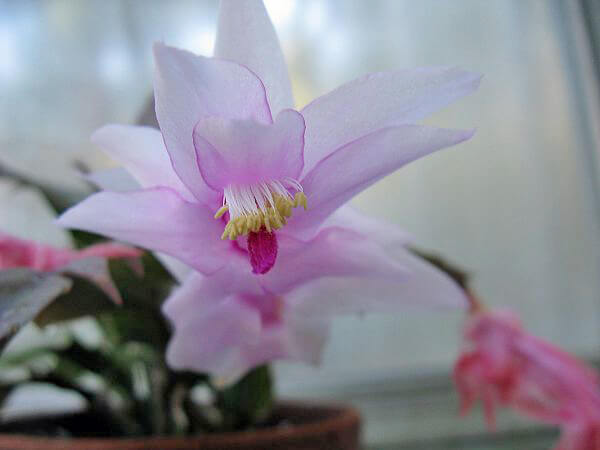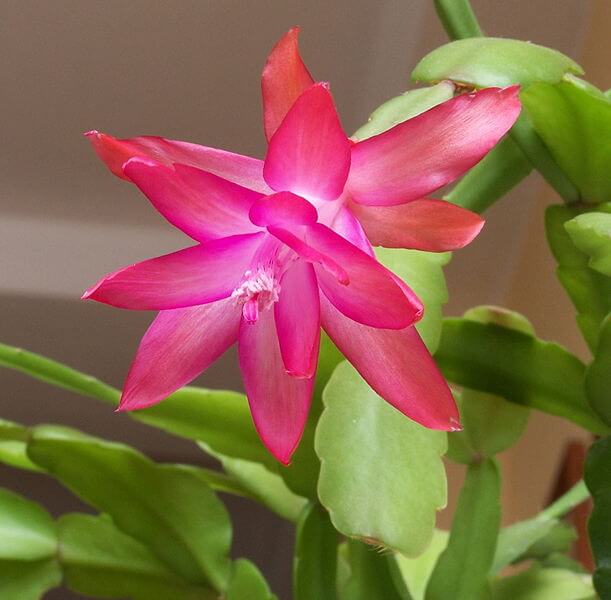
Most of us in the Frozen North could really use a hit of spring about now. How about flowers, for instance? Or better yet, how about a lush plant in full bloom, providing a colorful (and therapeutic) dose of midwinter cheer?
That won’t be happening in most of our gardens for a few weeks yet (although here in southern New England the early witch-hazels often open their spidery blooms before February is out). On the other hand, any number of plants will provide a bevy of winter blooms in a sun room or kitchen or any suitable indoor space, given a modest investment of care. Furthermore, some of them double their display with equally showy foliage.
Purple-leaved Oxalis
One sure sign of spring’s approach is the mass arrival of purple-leaved oxalis (Oxalis triangularis) in supermarkets and department stores, in anticipation of St. Patrick’s Day. This handsome and easy-to-grow perennial is much more than a one-holiday wonder, however. Although the deep-maroon, three-lobed, shamrock-like leaves give it obvious St. Patty’s Day caché, they are perhaps even more appealing in winter, especially when punctuated with the pale pink, funnel-shaped flowers that this South American native produces year-round. Plants can also be purchased as “bulbs”, which are actually scaly, caterpillar-like underground stems (rhizomes) that should be planted horizontally an inch or two below the soil surface in Fafard® Professional Potting Mix. Full to partial sun, almost any potting mix, and anything but total neglect will keep this tough perennial happy. It is also remarkably cold-hardy, functioning well as a foliage accent in mixed borders and other perennial plantings from Washington DC into the South.

Calatheas
Calatheas, like purple-leaved oxalis, are typically known and grown for their showy foliage. Yet, a few surprise us with blossoms that stand clear of the foliage in an arresting and anything-but-drab display – rather than cowering blandly near the bases of the leaves. Among the best of these showy-flowered peacock plants are a series of hybrids developed in Indonesia in the early 2000s. And none is better than the cultivar ‘Holiday’, whose striking blooms – with rose-pink, pale-eyed petals tipped with olive-green – open sporadically throughout the year. When not in flower, ‘Holiday’ provides ample ornament with its broadly oval, bright green leaves marked by purple-black chevrons and silvery, purple-edged margins. Other ever-blooming calathea hybrids include ‘Constellation’, ‘Jungle Cat’, ‘Maria’, and ‘Royal Standard.’ (Their flowery parent, Calathea loeseneri, also makes a wonderful subject for a shady indoor nook.) All calatheas prosper in full to partial shade, warm humid conditions (although they’ll tolerate less), and a coarse humus-rich potting medium. Fafard African Violet Potting Mix is a good fit. Repot and divide plants yearly or once every two years.

Orchids
Terrestrial to semi-terrestrial orchids of many types bloom beautifully in the winter months. Most notably are Cymbidium, Paphiopedilum, and Phaius species, grexes, and cultivars. All provide bright, long-lasting floral color and thrive in Fafard’s Premium Orchid Mix, which offers a perfect blend of fir bark, chopped coir and perlite.
Spiral Ginger
For sheer nonstop flower power and ease of care, few plants can match spiral ginger (Chamaecostus cuspidatus, formerly Costus cuspidatus). The golden-orange, ruffle-edged, blooms look almost orchid-like and appear year-round on cane-like, 2-foot-tall stems clothed with glossy, dark-green, broadly lance-shaped leaves. Flowering is most abundant in summer, but blooms continue to open throughout fall and winter, particularly in warm humid niches. Give it bright shade, a fertile compost-rich growing medium, such as Fafard® Organic Potting Mix, and moderate watering for maximum display. Other members of the costus tribe, like dwarf cone ginger (Costus woodsonii) and crepe ginger (Cheilocostus speciosus), thrive in similar conditions, and are also well worth seeking out.

Streptocarpus
No discussion of winter-blooming (and ever-blooming) houseplants would be complete without mention of cape primroses. Members of the southern African genus Streptocarpus, and close relatives of African violets, these little evergreen perennials perch easily on a modest windowsill (fitting happily in a 4-inch pot), where they bloom their heads off year-round, the funnel-shaped flowers smiling from atop wiry, 4- to 8-inch stems. Hybrids abound in all manner of luscious exotic colors and patterns, with the flowers’ two rounded, ear-like upper lobes typically differing in hue from the three lower ones, and their throats often bearing dramatic contrasting streaks. Partial shade, Fafard African Violet Potting Mix, mild humid summers, and coolish somewhat drier winters will result in nearly constant blooms, and loads of midwinter cheer.


















